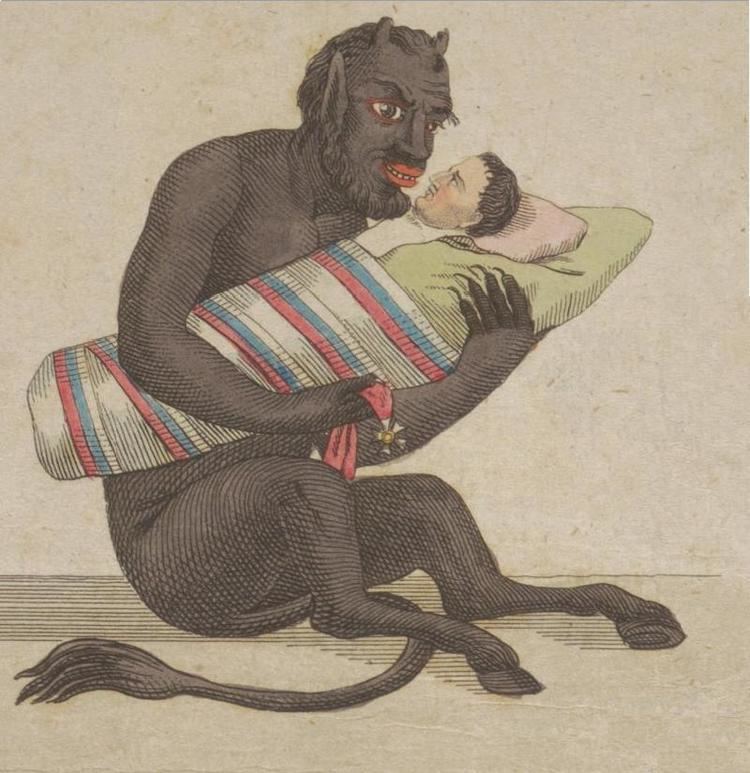 | ||
Chort (Russian: Чёрт, Belarusian and Ukrainian: Чорт, Polish: Czort and Czart, Czech and Slovak: Čert) is considered to be a demon of total evil, with horns, hoofs, skinny tail, and a pig-face in Slavic mythology (demonology). He is the son of the Slavic god Chernobog and the goddess Mara. In Ukraine, he is also known as haspyda, didko, irod, and kutsyi. In folk Christianity, he is considered a minion, or a synonym, of Satan.
Contents
Compare to sayings (curses) "tysjača čertej" (Russian) – meaning thousands of demons, "čort poberi" (Russian) – meaning as overtaken by the demon, the saying is often used as an acceptable version of cursing in the Eastern Europe, "čort poputal" (Russian) – meaning mixed up by the demon, "k čertjam" (Russian) – meaning to hell, and many others.
In Turkic culture
In Turkic (usually neighboring Slavic) folklore its name is Chor (In Turkish and Azerbaijan languages: Çor). In Anatolia known as Chorabash. Chors are spiritual creatures mentioned in the pre-Islamic texts and oral tradition who inhabit an unseen world in dimensions beyond the visible universe of humans. Folk narratives mentions that the Chors are made of fire, but also physical in nature, being able to interact physically with people and objects and likewise be acted upon. Like human beings, the Chor can also be good (Ak-çor "White-Chor"), evil (Kara-çor "Black-Chor"), or neutrally benevolent and hence have freewill like humans and unlike angels. The exorcist are called Çoraman in Anatolia. There are two different kinds of Chura. The one (Archura) that comes from the forest is married to the Orman iyesi. The other one (Bichura) comes from the cellar and she is married to Ev iyesi.
In Czech and Slovak culture
In Czech folk tales, čert is not an evil character per se. It is often trying to tease characters in selling their souls in exchange for something (money, power, completion of a task). This often ends badly for evil or greedy characters, who are tricked into getting useless gifts and then are carried into hell. Other times, čert changes roles from trickster to tricked as he loses a bet against a hero, who outsmarts him, winning his soul back. This way, čert is often tricked to build castle walls in a day, dig fish ponds or even whole river banks, move large stones or create hills and mountains. Sometimes, a positive role of čert is further emphasized, namely in modern or modernized folk tales. Čert is trying to bring evil characters to hell, he often helps or befriends heroes in this process and gives them various magical items and treasures.
The true form of Čert is an often smallish hairy man with a tail, horns and one or two hoofs. But he is a shapeshifter and he tries to trick characters in his nicer forms, before they even realize that what he is. In these forms, he is often represented as pretty young man, count or huntsman (see The Devil and Kate). Often, this transformation is not (and cannot be) complete, so one can recognize čert by small horns hidden in black curly hair, or a single hoofed leg hidden in high boots.
Čert is not the devil, although they might have a lot in common. Sometimes, hell is full of čert and is ruled by devil (or archdevil) Lucifer.
Etymology
There are many theories regarding the origins of the Proto-Slavic word *čьrtъ. One is that it's a substantivized t-participle of *ker- (to cut, to chop), which could be derived from chorts imagined as being lame (having one leg shorter). The words like Ukrainian kutsiy and Czech and Slovak kusý, also derived from *ker-, are one of chort's most common epithets.
